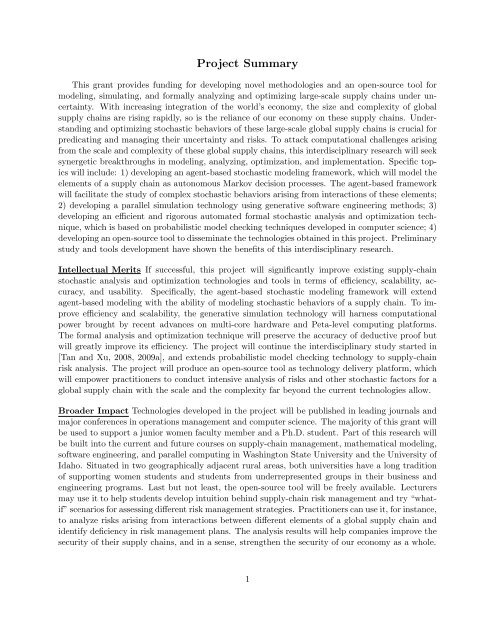SimRisk: An Integrated Open-Source Tool for Agent-Based ...
SimRisk: An Integrated Open-Source Tool for Agent-Based ...
SimRisk: An Integrated Open-Source Tool for Agent-Based ...
Create successful ePaper yourself
Turn your PDF publications into a flip-book with our unique Google optimized e-Paper software.
Project Summary<br />
This grant provides funding <strong>for</strong> developing novel methodologies and an open-source tool <strong>for</strong><br />
modeling, simulating, and <strong>for</strong>mally analyzing and optimizing large-scale supply chains under uncertainty.<br />
With increasing integration of the world’s economy, the size and complexity of global<br />
supply chains are rising rapidly, so is the reliance of our economy on these supply chains. Understanding<br />
and optimizing stochastic behaviors of these large-scale global supply chains is crucial <strong>for</strong><br />
predicating and managing their uncertainty and risks. To attack computational challenges arising<br />
from the scale and complexity of these global supply chains, this interdisciplinary research will seek<br />
synergetic breakthroughs in modeling, analyzing, optimization, and implementation. Specific topics<br />
will include: 1) developing an agent-based stochastic modeling framework, which will model the<br />
elements of a supply chain as autonomous Markov decision processes. The agent-based framework<br />
will facilitate the study of complex stochastic behaviors arising from interactions of these elements;<br />
2) developing a parallel simulation technology using generative software engineering methods; 3)<br />
developing an efficient and rigorous automated <strong>for</strong>mal stochastic analysis and optimization technique,<br />
which is based on probabilistic model checking techniques developed in computer science; 4)<br />
developing an open-source tool to disseminate the technologies obtained in this project. Preliminary<br />
study and tools development have shown the benefits of this interdisciplinary research.<br />
Intellectual Merits If successful, this project will significantly improve existing supply-chain<br />
stochastic analysis and optimization technologies and tools in terms of efficiency, scalability, accuracy,<br />
and usability. Specifically, the agent-based stochastic modeling framework will extend<br />
agent-based modeling with the ability of modeling stochastic behaviors of a supply chain. To improve<br />
efficiency and scalability, the generative simulation technology will harness computational<br />
power brought by recent advances on multi-core hardware and Peta-level computing plat<strong>for</strong>ms.<br />
The <strong>for</strong>mal analysis and optimization technique will preserve the accuracy of deductive proof but<br />
will greatly improve its efficiency. The project will continue the interdisciplinary study started in<br />
[Tan and Xu, 2008, 2009a], and extends probabilistic model checking technology to supply-chain<br />
risk analysis. The project will produce an open-source tool as technology delivery plat<strong>for</strong>m, which<br />
will empower practitioners to conduct intensive analysis of risks and other stochastic factors <strong>for</strong> a<br />
global supply chain with the scale and the complexity far beyond the current technologies allow.<br />
Broader Impact Technologies developed in the project will be published in leading journals and<br />
major conferences in operations management and computer science. The majority of this grant will<br />
be used to support a junior women faculty member and a Ph.D. student. Part of this research will<br />
be built into the current and future courses on supply-chain management, mathematical modeling,<br />
software engineering, and parallel computing in Washington State University and the University of<br />
Idaho. Situated in two geographically adjacent rural areas, both universities have a long tradition<br />
of supporting women students and students from underrepresented groups in their business and<br />
engineering programs. Last but not least, the open-source tool will be freely available. Lecturers<br />
may use it to help students develop intuition behind supply-chain risk management and try “whatif”<br />
scenarios <strong>for</strong> assessing different risk management strategies. Practitioners can use it, <strong>for</strong> instance,<br />
to analyze risks arising from interactions between different elements of a global supply chain and<br />
identify deficiency in risk management plans. The analysis results will help companies improve the<br />
security of their supply chains, and in a sense, strengthen the security of our economy as a whole.<br />
1




